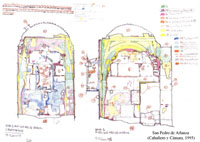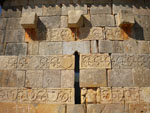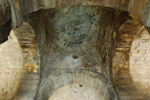Masons at Work
María de los Ángeles Utrero Agudo
Instituto de Historia (IH), Centro de Ciencias Humanas y Sociales (CCHS), Consejo Superior de Investigaciones Científicas (CSIC),

María de los Ángeles Utrero Agudo
Instituto de Historia (IH), Centro de Ciencias Humanas y Sociales (CCHS), Consejo Superior de Investigaciones Científicas (CSIC),
Building Churches in the 8th–10th Centuries in the Iberian Peninsula. Technology and Context
This papers intends to show how Hispanic churches were designed and built for two centuries
(8th–10th), those following the Islamic conquest of the Iberian Peninsula in 711, by drawing
its attention on three main points: how the archaeology has been clue to advance in the study
of the standing buildings dated to those periods, how building practices and technologies have
been identified thanks to it and why these are thought to be the result of the arrival of the
Islamic people, and not the continuity of previous (Roman and Visigothic) building traditions.
The introduction of the method of the Archaeology of Architecture in the study of late
antique and early medieval Hispanic churches in the 1990s (Fig. 1) went together with the
proposal of a new historical model which defended that the Islamic conquest of Hispania
meant a rupture both stylistically and technologically.1 Sculpture (iconography style,
technique and elements, friezes for instance; Fig. 2) and building (vaulted roofs or ashlar
stone masonry) innovations should be attributed to those new techniques and artisans arrived
with Islamic conquest, and those buildings which owned those innovations should be then redated
to a post-conquest moment and not to the Visigothic period (7th century) as they had
been hitherto according to the prevailing opinion, this one based on a continuity explanation.2
Fifteen years later, two main consequences must be drawn from the archaeological analysis carried out in some of these Hispanic churches. Firstly, traditional groups of architecture dated to from 8th to 10th centuries (Asturian and Mozarabic) according to stylistic criteria, start now to be substituted by groups of churches, usually related geographically (Asturias, Valladolid-León, Burgos-La Rioja-Álava,3 among others), thought to be built and decorated by same workshops and therefore to be coetaneous. These groups belong to a same "technical environment",4 which is reflected in a common technology, understood this one as practical knowledge encompassing artefacts and techniques employed by artisans to develop their work, but they show specific features which are the result of different workshops and temporal associations among them according to context. This one plays besides a main role, determining the existence of enough demand for workshops to survive and technology to be transmitted, of sufficient funding for complex structures or splendid decoration to be developed and also allowing the circulation of models through different means of transport (artisans, patrons and documents).
Secondly, the idea of a technology which evolves linearly from Roman to Early Medieval periods, being unaffected by the Islamic conquest in 711, can not be defended when analysing it from an archaeological point of view. Ashlar stone masonry and vaulting technique (Fig. 3), for instance, was completely lost in the West,5 not in the East though, where transfer of practical expertise through building production in Byzantine and Islamic environments preserved it. Its introduction in the Iberian Peninsula may be only explained by considering the presence of experienced builders who were familiar to structural working.

Fig. 1. Building recording of the apse of San Pedro de Arlanza (Burgos) in the early 90s (Caballero and Cámara 1995).6

Fig. 2. External friezes at the apse of Santa María in Quintanilla de las Viñas (Burgos), photograph by author.

Fig. 3. Stone pendentive dome at the crossing of Santa María de Melque (Toledo) and remains of stuccos, photograph by author.
Fifteen years later, two main consequences must be drawn from the archaeological analysis carried out in some of these Hispanic churches. Firstly, traditional groups of architecture dated to from 8th to 10th centuries (Asturian and Mozarabic) according to stylistic criteria, start now to be substituted by groups of churches, usually related geographically (Asturias, Valladolid-León, Burgos-La Rioja-Álava,3 among others), thought to be built and decorated by same workshops and therefore to be coetaneous. These groups belong to a same "technical environment",4 which is reflected in a common technology, understood this one as practical knowledge encompassing artefacts and techniques employed by artisans to develop their work, but they show specific features which are the result of different workshops and temporal associations among them according to context. This one plays besides a main role, determining the existence of enough demand for workshops to survive and technology to be transmitted, of sufficient funding for complex structures or splendid decoration to be developed and also allowing the circulation of models through different means of transport (artisans, patrons and documents).
Secondly, the idea of a technology which evolves linearly from Roman to Early Medieval periods, being unaffected by the Islamic conquest in 711, can not be defended when analysing it from an archaeological point of view. Ashlar stone masonry and vaulting technique (Fig. 3), for instance, was completely lost in the West,5 not in the East though, where transfer of practical expertise through building production in Byzantine and Islamic environments preserved it. Its introduction in the Iberian Peninsula may be only explained by considering the presence of experienced builders who were familiar to structural working.

Fig. 1. Building recording of the apse of San Pedro de Arlanza (Burgos) in the early 90s (Caballero and Cámara 1995).6

Fig. 2. External friezes at the apse of Santa María in Quintanilla de las Viñas (Burgos), photograph by author.

Fig. 3. Stone pendentive dome at the crossing of Santa María de Melque (Toledo) and remains of stuccos, photograph by author.
- Caballero, L. 1994/95, "Un canal de transmisión de lo clásico en la Alta Edad Media Española. Arquitectura y Escultura de influjo omeya en la Península Ibérica entre mediados del siglo VIII e inicios del siglo X", Al-Qantara XV/2, 321–348 and XVI/1, 107–124. ↑
- Revised in Utrero, M. 2010, "Late Antique and Early medieval Hispanic churches and the archaeology of architecture: revisions and reinterpretation of constructions, chronologies and contexts", Journal of Medieval Archaeology 54, 1–33. ↑
- Caballero, L. 2001, "Aportación a la arquitectura altomedieval española. Definición de un grupo de iglesias castellanas, riojanas y vascas", V Congreso de Arqueología Medieval Española, Valladolid (1999), vol. 1, 221–233; and Sánchez Zufiaurre, L. 2009: "Metodología. Las iglesias de Álava de los siglos IX-XI y las consideradas iglesias del siglo VII", in Caballero, L. et alii (eds.): El siglo VII frente al siglo VII: Arquitectura, Anejos de AEspA 51, Madrid, 231–239. ↑
- Term coined by Bianchi, G. 1996, "Trasmissione dei saperi tecnici e analisi dei procedimenti costruttivi di età medieval", Archeologia dell'Architettura I, 53–64. ↑
- Mannoni, T. 2007, "The transmission of craft techniques according to the principles of material culture: continuity and rupture", in Lavan, L., Zanini, E. and Sarantis, A. (eds.), Technology in Transition. A. D. 300- 650, Late Antique Archaeology 4, Leiden-Boston, xli-lx (p. xlv). ↑
- Caballero, L. and Cámara, L. 1995: "Un caso de lectura de paramento y argumentación científica. San Pedro el Viejo de Arlanza, Burgos-España", in Caballero, L. and Latorre, P. (coords.): Leer el documento construido, Informes de la Construcción, vol. 46, nº 435, Madrid, 79-89. ↑